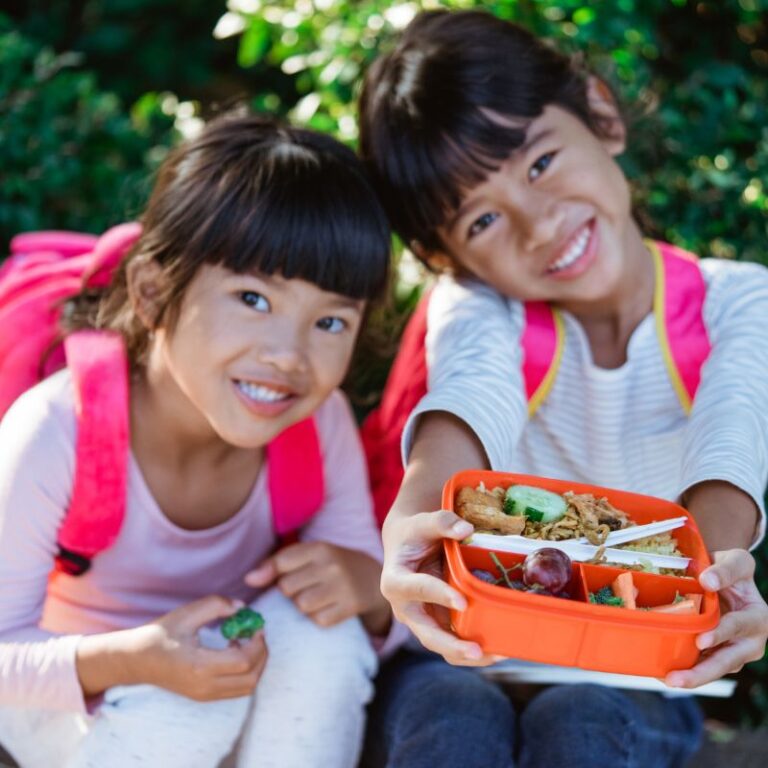“My kid is obsessed with sugar.”
This is not an uncommon statement that I hear from parents or caregivers when I meet them for their first consultation. So many families live with an ongoing power struggle between them and their children over sugar.
Parents are worried that their children are eating too much sugar and not getting enough essential nutrients. Children feel like they are completely deprived. This creates tension and full blown battles around foods with sugar. The holidays often bring this tension to light as there is greater access to these foods.
Is it possible for children to NOT be obsessed with sugar at Christmas or any other time of the year?
Yes. Please believe me when I say it really IS possible.
But here are a few things that need to know first.
We need to adopt a nuanced view about sugar.
There are three predominant and contrasting viewpoints when it comes time to sugar. The first is a ‘sugar is toxic – don’t bring it in the house’ view. The second is a ‘who cares – eat as much as you like’ approach. Both these outlooks are black and white. They’re neither accurate nor helpful for your child to develop a good relationship with food and sugar.
The third view is a nuanced approach that lives in the grey zone. It recognizes that reducing added sugars in foods that we consume regularly is helpful but that kids can and should enjoy foods with obvious sugar. This view reflects best practice feeding principles for children and is helpful for kids to foster a healthy relationship with sweets.
However, since many families, prior to working with me, have held the opinion that ‘sugar is toxic’ for a long time, I’d like to take a look at this viewpoint in more detail.
We need to normalize sugar in our homes.
Our society is heavily influenced by diet culture. The messages being shared through mainstream media make parents feel like their children can’t have any sugar because it’s not on the “clean eating” food list.
Our intentions as parents are well meaning. Refined sugars aren’t needed for survival and when there are so many other foods that provide nutrients for growth, it’s reasonable to want your kids to eat those instead of ice cream. This may lead you to provide only limited access to foods like cake, cookies, chocolate etc.
Practically speaking, “limited access” may look like:
- Allowing dessert only if a certain number of bites of food were eaten at supper
- Only having dessert for birthdays or holidays or NOT letting them eat dessert at these holidays
- Always “health-ifying” desserts with low sugar alternates
- Micromanaging how much they eat of their portion – not allowing them to self-regulate
What you may not realize is that this tight restriction of sugar is actually creating or fuelling the problem. An “avoid-at-all-costs” mentality around sugary foods is linked to:
- Drawing children’s attention MORE towards the restricted food and increasing their determination to get it, sometimes at all costs, including sneaking or stealing
- If or when children get access to the forbidden food, their consumption of that food is greater than if the food had not been restricted (here)
- Some children are more susceptible to the negative effects of restriction. One study found that preschool children with low inhibitory control (i.e. kids who find it difficult to resist or delay gratification), and high levels of motivation to search out food ate bigger amounts when a restricted food was obtained. (here)
- Children who are restricted or deprived of highly palatable snack foods (i.e. high-sugar or high-fat foods) show high levels of eating in the absence of hunger, and tend to eat more and feel worse about their eating when they do get to consume the treat food. (here and here)
Taken together, we can conclude that NOT allowing sugar/treats isn’t the best approach.
But what if I allow more access to sugar and my child eats way too much?
Sometimes what happens when we liberalize sugar after a period of restriction, kids are even MORE focused on it than before. They only eat the cookie or gummy bears that we pack in their lunchbox. Or they only eat their dessert and none of the other offerings at supper. They routinely ask when cake is on the menu again.
This is normal. In fact, you should expect it.
However, if you continue to provide structure and consistency around sweets, then, overtime, this fixation will lessen. Sugar will start to become an equal alongside other foods. This may look like your child not always choosing to eat dessert. Or, they may leave part of their dessert behind because of their new-found ability to self-regulate and eat until their tummies are satisfied. Your child may also ask a lot less about when dessert is on the menu.
Long story short …
We need to remember that sugar is NOT going anywhere. It’s here to stay. And when your child leaves home someday, we want him or her to know how to self-regulate around it, so that they can enjoy a cookie and move on with their day.
We need to help our kids make peace with sugar.
So, as you consider the upcoming holidays or if you’re reading this in the middle of the summer, here are 5 important starting points to help you neutralize sugar in your home all year long.
5 tips to neutralize sugar at home

1. Evaluate your own mindset and fear around sugar
Have you ever considered how your own personal thoughts and fears around sugar may be impacting the current situation?
What I mean here is that if you personally see sugar as the enemy, then it’s going to be hard to try to loosen the reigns a bit and allow yourself and your child to truly ENJOY a sweet food together.
Like I said earlier, sugar is here to stay. We can choose to either fight against it and let deprivation, restriction, bingeing, shame and guilt associated with eating it rule our lives. Or, we can choose to embrace it, work with it, enjoy it and embrace a nuanced approach as previously highlighted.
This may necessitate a small mindset shift or complete 180 degree transformation for you. This process takes time. Don’t expect it to happen overnight. You can still encourage your kids to have a good relationship with sugar even if yours is still a bit rocky.
And on this note, do not blame yourself. The strong pull of diet culture in our society is largely to blame for our warped relationship with what it calls “unhealthy” foods. The messaging is subtle but strong. It’s also very hard to block out because it’s everywhere.
As you navigate a new mindset shift, plan to lead by example and sit and enjoy some sweet foods together with your kids, without a dose of guilt, shame or negative comments.
2. Take notice of how you talk about sweets and sugar.
Our words our so powerful. What we say and how we say it can profoundly impact how our children view food, nutrition and their bodies.
As a mom of two school-age kids, this has become quite apparent to me. My kids absorb everything that I say like dry sponges! I have to be careful in particular with my daughter who relays most everything I say to her kindergarten teachers!
So when sitting down to eat cookies with my kids I can either make it a positive experience by saying “these cookies are soft and chewy – just the way I like them!” Or, I can say “these cookies are very sugary; too many cookies are bad for us so just eat one and we will give the rest away.”
The first scenario allows parent and child to enjoy and feel good about eating cookies. It’s a pleasant experience, cultivating happy memories.
The second scenario makes us feel guilty for eating cookies and restricted. This can potentially lead to our children sneaking cookies later and can lay the foundation for restriction-bingeing cycles. Ultimately, setting the stage for a not-so-fantastic relationship with sugar or food in general.
Another way our verbiage affects our children has to do with how we give special labels to sugary foods.
Your child may be fixated on foods high in sugar because of how you’ve (unknowingly) elevated their status with the words you use to describe them. One of the most common ways that parents or caregivers do this is by calling sugary foods “treats”.
By calling a sugary food (like a donut) a treat, we in fact make it so much more exciting than if we just called it by its name – a donut. The word treat creates a superstar status for the food, effectively placing it on a pedestal. We tend to reserve this term for foods high in sugar, fat or salt. (I’m sure you’ve never called celery a treat!).
When we call food by its name instead of giving it a category (healthy/unhealthy; good/bad; treat/everyday food), we help kids to see it for what it is. Food. No categorization required.
3. Allow foods high in sugar regularly with meals and snacks. Not just at holidays.
You may also be experiencing an increase in perceived ‘sugar-obsession’ around the holidays if you normally restrict sugary foods and then the availability suddenly increases. As previously mentioned, research supports that restriction leads to increased fixation on the restricted food and greater intake of the restricted food once it becomes available.
The restriction makes the wanting of that food so much more.
So, instead, I would recommend that you actually include sugar-rich foods in your children’s diets on a regular basis – with meals or snacks. How do you do this? Here are a few suggestions, as recommended by child and family feeding expert Ellyn Satter:
- Once a week offer a food higher in sugar in an unlimited quantity alongside some other foods for your child’s snack. For example, some milk and nuts along with a plate of cookies. Let him or her eat until they’ve had their fill, without a stare-down or your commentary. Trust in your child’s innate ability to self-regulate.
- When you’ve planned to have dessert, offer one piece WITH your dinner. This helps kids understand that brownies or cookies are simply foods, just like the rest of the dinner items. It effectively equalizes the playing field. By doing this, you allow your child to fully self-regulate and decide what to eat from what is being offered.
4. Give kids opportunities to self-regulate and learn more about their bodies.
On this note, there is great value in letting children eat until they’ve had their fill, even with foods high in sugar. This might look like allowing your child to eat cookies and milk for snack and eat until they decide to stop; or allowing your kids to manage their halloween haul and eat until they’re satisfied on the night of Halloween.
Will your child potentially overeat, especially if you’re in the beginning stages of easing up on restriction? Possibly yes. Will your child, overtime start to learn at what point to stop eating so that they don’t get past full? Yes … if we are consistent in providing access, as well as loving boundaries around sugar.
This is often one of the most anxiety-inducing exercises for parents in the beginning, which can highlight a current lack of trust in the feeding relationship.
5. Build from the ground up. Focus on nurturing a TRUSTING feeding relationship
If we peel back all the layers that we have explored, at the core of the conversation we need to have a trusting feeding relationship with our child.
When trust is the foundation of the feeding relationship, it’s a ‘piece of cake’ (pardon the pun!) to watch your child eat a brownie (or three!) and not freak out. This in turn allows our kids to build confidence around all foods.
How do you build a feeding relationship built on trust? Start with the division of responsibility. Trust yourself to do your jobs (providing the what, when and where of eating) and trust your child to do theirs (decide if/how much to eat). Put a stop to stealing each other’s jobs and have confidence that when you stay on your side of the road, your child will stay on theirs. Have faith that they will, eventually, learn how to become a competent eater.
If you’ve lost all trust and don’t know where to start with any of this, reach out for help. You may potentially feed your child up to 32,000 times or more in a span on 18 years! Having guidance now will help make this journey so much more enjoyable.
If you enjoyed this article, I recommend you check out the article; Picky Eating 101: Should your kids “take one bite to be polite?”, before you leave. It might make all the difference to what you are struggling with or the information you are looking for.








